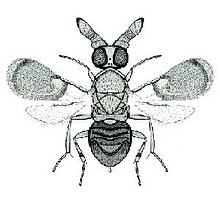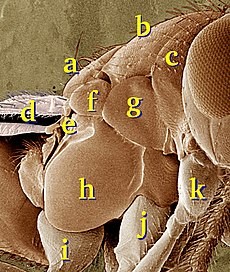Encyrtidae
| Encyrtidae Temporal range:
| |
|---|---|

| |
| Anicetus communis | |
| Scientific classification | |
| Domain: | Eukaryota |
| Kingdom: | Animalia |
| Phylum: | Arthropoda |
| Class: | Insecta |
| Order: | Hymenoptera |
| Superfamily: | Chalcidoidea |
| Family: | Encyrtidae Walker, 1837 |
| Subfamilies | |
| Diversity | |
| Two subfamilies of around 3710 species in 455 genera | |
Encyrtidae is a large family of
biological control agents. They may also present as an ecological threat to the population of some species. For example, the endangered Papilio homerus butterfly is parasitized at a rate of 77%,[1]
making them the main contributor to egg mortality in this (and other) butterfly species.
Some species exhibit a remarkable developmental phenomenon called "
eusocial insects, attacking any other wasp larvae already in the body of the host, and dying without reproducing ("altruism").[2]
Wasps in this family are relatively easy to separate from other
mesopleuron
with anteriorly positioned mesocoxae.

An extinct genus Middle Eocene age Sakhalin amber in Eastern Russia.[3]
References
- ISBN 9781402087813.
- ^ a b Segoli, M., Harari, A. R., Rosenheim, J. A., Bouskila, A., & Keasar, T. (2010). The evolution of polyembryony in parasitoid wasps. Journal of evolutionary biology. 23 (9), 1807-1819. DOI
- S2CID 86655697.
External links
- Universal Chalcidoidea Database
- Image Database TOBIKOBACHI Based on the Encyrtid Wasp Collection of Dr. T. Tachikawa Archived 2009-03-05 at the Wayback Machine
- Ageniaspis citricola on the UF / IFAS Featured Creatures Web site
- Diaphorencyrtus aligarhensis on the UF / IFAS Featured Creatures Web site
